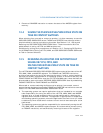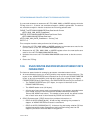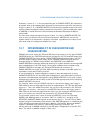
Vol. 3 13-9
SYSTEM PROGRAMMING FOR INSTRUCTION SET EXTENSIONS AND
• Execute a LDMXCSR instruction to restore the state of the MXCSR register from
memory.
13.4 SAVING THE SSE/SSE2/SSE3/SSSE3/SSE4 STATE ON
TASK OR CONTEXT SWITCHES
When switching from one task or context to another, it is often necessary to save the
SSE/SSE2/SSE3/SSSE3/SSE4 state. FXSAVE and FXRSTOR instructions provide a
simple method for saving and restoring this state. See
Section 13.3, “Saving and
Restoring the SSE/SSE2/SSE3/SSSE3/SSE4 State.” These instructions offer the
added benefit of saving x87 FPU and MMX state as well.
Guidelines for writing such procedures are in Section 13.5, “Designing OS Facilities
for AUTOMATICALLY Saving x87 FPU, MMX, and SSE/SSE2/SSE3/SSSE3/SSE4 state
on Task or Context Switches.”
13.5 DESIGNING OS FACILITIES FOR AUTOMATICALLY
SAVING X87 FPU, MMX, AND
SSE/SSE2/SSE3/SSSE3/SSE4 STATE ON TASK OR
CONTEXT SWITCHES
The x87 FPU/MMX/SSE/SSE2/SSE3/SSSE3/SSE4 state consist of the state of the x87
FPU, MMX, XMM, and MXCSR registers. The FXSAVE and FXRSTOR instructions
provide a fast method for saving ad restoring this state. If task or context switching
facilities are already implemented in an operating system or executive and they use
FSAVE/FNSAVE and FRSTOR to save the x87 FPU and MMX state, these facilities can
be extended to save and restore SSE/SSE2/SSE3/SSSE3/SSE4 state by substituting
FXSAVE/FXRSTOR for FSAVE/FNSAVE and FRSTOR.
Where task or content switching facilities must be written from scratch, several
approaches can be taken for using the FXSAVE and FXRSTOR instructions to save and
restore x87 FPU/MMX/SSE/SSE2/SSE3/SSSE3/SSE4 state:
• The operating system can require applications that are intended be run as tasks
take responsibility for saving the state of the x87 FPU, MMX, XMM, and MXCSR
registers prior to a task suspension during a task switch and for restoring the
registers when the task is resumed. This approach is appropriate for cooperative
multitasking operating systems, where the application has control over (or is able
to determine) when a task switch is about to occur and can save state prior to the
task switch.
• The operating system can take the responsibility for automatically saving the x87
FPU, MMX, XMM, and MXCSR registers as part of the task switch process (using
an FXSAVE instruction) and automatically restoring the state of the registers


















